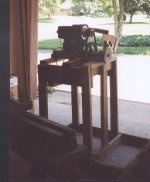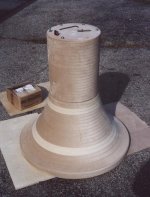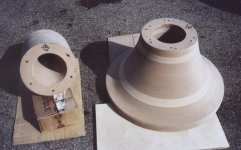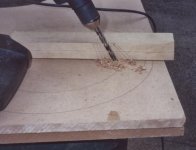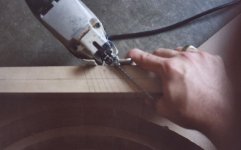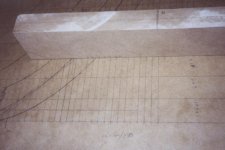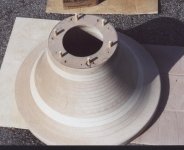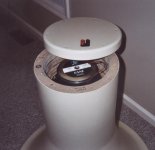You'll want to turn it in at least two sections. When you construct your lathe, make sure you can get the turning speed down around 100 RPM. The more weight you have, the slower you need to turn it. The imbalance of heavy turnings can shake and destroy your whole lathe. Turn it slow, and you should not have too many problems.
I used a Sears Craftsman lathe with a pulley reduction system I designed. I used a 4" pulley on the stockhead spindle and a 12" pulley on the support shaft. The support shaft is 1 & 3/4" diameter steel and is threaded to accept the faceplate. I used pillow bearings on both ends of the support shaft.
The wall thickness is 2 & 1/4" thick on the pictured 142Hz horn. Each half weighed about 85 pounds before turning. The finished horn was about 155 pounds.
Due to the weight of such a project I need to caution you to be VERY, VERY careful. You can really hurt yourself if you loose control of your turning.
Rgs, JLH
I used a Sears Craftsman lathe with a pulley reduction system I designed. I used a 4" pulley on the stockhead spindle and a 12" pulley on the support shaft. The support shaft is 1 & 3/4" diameter steel and is threaded to accept the faceplate. I used pillow bearings on both ends of the support shaft.
The wall thickness is 2 & 1/4" thick on the pictured 142Hz horn. Each half weighed about 85 pounds before turning. The finished horn was about 155 pounds.
Due to the weight of such a project I need to caution you to be VERY, VERY careful. You can really hurt yourself if you loose control of your turning.
Rgs, JLH
Attachments
Nifty work on that extra reduction. Thanks I was aiming for 100rpm. I have a 1hp 1440 rpm motor and a heap of pulleys and bearings, just need to get some steel tube and a face plate.
JLH how do you secure the two halves together after machining?
I will be exercising extreme caution and wont be turning this beast without someone else with me.
JLH how do you secure the two halves together after machining?
I will be exercising extreme caution and wont be turning this beast without someone else with me.
Nifty work on that extra reduction. Thanks I was aiming for 100rpm. I have a 1hp 1440 rpm motor and a heap of pulleys and bearings, just need to get some steel tube and a face plate.
JLH how do you secure the two halves together after machining?
I will be exercising extreme caution and wont be turning this beast without someone else with me.
here you can have a look step by step, how i made my midbass horns:
make of the 38" lower midrange horn - Audio Voice Acoustics
i did need to cement the lathe into the floor, to make it stable......
Just as I decide to build this horn Fane is rereleasing a limited run of Its 8M studio drivers. I think I will stick with the Radian compression driver though.
Thanks all for your help so far, I might make some dust this weekend!
Thanks all for your help so far, I might make some dust this weekend!
I use wood dowel rods. Between the dowels and the gluing surface area, the bond is stronger than the MDF material. I've got horns that are 12 years old and they are just as solid as the day they were made. Modern adhesives are really good.
Rgs, JLH
Rgs, JLH
To save time and work on the lathe you should set your saw to the angle for each layer. I leave about 1/8" of extra material when I cut each layer. This leaves very little to clean up on the lathe.
Attachments
Thanksd JLH. I am considering screws and or wooden dowels and will use Titebond II for the adhesive. I plan on using a router to cut the circles, not sure how I can set the angle with that. I do have a jigsaw and will look at using that with the angle set. I can definately see the advantage of putting in a little extra time on the cutting and just needing a sand/ finish on the lathe. I really dont want to be removing too much material on the lathe.
Fane is rereleasing a limited run of Its 8M studio drivers.
Where did you find this information? Couldn't find anything about it on the Fane web site. I know Eminence bought most of the old Fane remains a few years back. It would be really cool to be able to buy the Studio 8M new again.
Where did you find this information? Couldn't find anything about it on the Fane web site. I know Eminence bought most of the old Fane remains a few years back. It would be really cool to be able to buy the Studio 8M new again.
http://www.diyaudio.com/forums/grou...y-fane-8m-studio-50-units-production-run.html
A good thing about separating into two sections is to make the front-section suit a 8"(or Lowther)-12" cone driver that sims well. Think 8" is better as 12" due, its normally higher, cone-mass probably will need som compression.
Hi Lars,
I was just outside looking at my new template, designed with Jean-Michels latest spreadsheet and the idea of making the join at the 4" opening area, to give 2:1 compression for a 8" driver (just under with the actuel Sd of an 8" probably) is very doable. I would just need a nice clean way to make the two halves removeable. This could possably be done with 8 or so fixings from the rear of the horn.
I was just outside looking at my new template, designed with Jean-Michels latest spreadsheet and the idea of making the join at the 4" opening area, to give 2:1 compression for a 8" driver (just under with the actuel Sd of an 8" probably) is very doable. I would just need a nice clean way to make the two halves removeable. This could possably be done with 8 or so fixings from the rear of the horn.
Where did you find this information? Couldn't find anything about it on the Fane web site. I know Eminence bought most of the old Fane remains a few years back. It would be really cool to be able to buy the Studio 8M new again.
Romy's site.
JLH,
The published data shows a very,very high cone mass for being a 8" at 36gram. Sounds almost unreal for a 8". This gives us a a -3db at ca 1000Hz. Also ca 10:1 should be needed. Maybe the group-buy seller can help.
Suppose you have tried it. What about reality?
The published data shows a very,very high cone mass for being a 8" at 36gram. Sounds almost unreal for a 8". This gives us a a -3db at ca 1000Hz. Also ca 10:1 should be needed. Maybe the group-buy seller can help.
Suppose you have tried it. What about reality?
JLH,
The published data shows a very,very high cone mass for being a 8" at 36gram. Sounds almost unreal for a 8". This gives us a a -3db at ca 1000Hz. Also ca 10:1 should be needed. Maybe the group-buy seller can help.
Suppose you have tried it. What about reality?
The specs for this woofer do not tell the story behind its sound. This is the very reason why it has been over looked. Most of the time when we go to design a new horn we hunt for a woofer with a certain set of specifications. I do not know of another woofer that sounds better in a horn loaded application than the Studio 8M. It slays all other woofers. In that 142Hz horn I built it would do 135Hz - 5KHz at 109dB 1W/1M without the asisstance of a phase plug. Try accomplishing that with any other woofer. Yes, its that damn good of a woofer.
Thanksd JLH. I am considering screws and or wooden dowels and will use Titebond II for the adhesive. I plan on using a router to cut the circles, not sure how I can set the angle with that. I do have a jigsaw and will look at using that with the angle set. I can definately see the advantage of putting in a little extra time on the cutting and just needing a sand/ finish on the lathe. I really dont want to be removing too much material on the lathe.
Early on I did my cutting with a router too. Later I switched to using a jigsaw and setting the angle of the saw for each layer. I switched because the square cuts from the router took 3 times the amount of time to turn on the lathe. I would highly recommend you use a jigsaw instead of a router. The jigsaw will save you from many hours of cussing infront of the lathe. 😀
I do not know of another woofer that sounds better in a horn loaded application than the Studio 8M..
John
did you not say the Faital were better ?
Hey JLH,
Good to know. Then the data from Fane is wrong. Do you know compression ratio with the phaseplug inserted?
Good to know. Then the data from Fane is wrong. Do you know compression ratio with the phaseplug inserted?
JLH I am off to buy a nice new jigsaw today, it does make sense to cut the angle in the mdf, which can easily be measured from the template.
John
did you not say the Faital were better ?
That is a subjective opinion. Strictly speaking, the Fane out performs the Faital on actual frequency and SPL measurements.
Hey JLH,
Good to know. Then the data from Fane is wrong. Do you know compression ratio with the phaseplug inserted?
No, the T/S parameters actually measure within about 7% of the spec sheet on the 4 differnet ones I've measured. Mmd, Qes, and Qts measure a little lower. The Fane 8M just performs better in real life than what the specs would lead us to believe. I agree this is strange, but true.
I used a 4" throat on that 142Hz tractrix. What phase plug?
Rgs, JLH
Last edited:
- Status
- Not open for further replies.
- Home
- Loudspeakers
- Multi-Way
- My Le Cleac'h horn build


